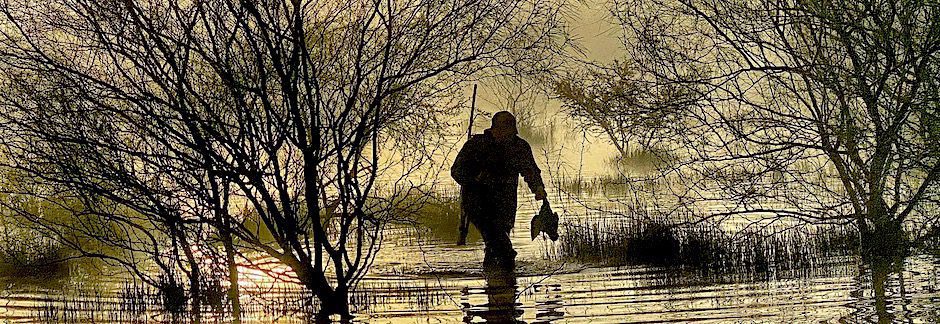MOJO’S Duck Season Somewhere Podcast
EP 331. Best Steak in Dallas, Texas

While the best steak in Dallas, Texas, might be fighting words, I’ll stand by them. I knew this was going to be the case while walking up to Brandon Roy’s patio, seeing a deep bed of hot coals glowing in his custom parilla. “You have to respect first contact,” he later says about grilling steaks perfectly. But way more goes into it. See, for Brandon Roy, the entire process of grilling and smoking meats is a labor of love. And it shows.
Related Links:
EP 330. A Duck Calling Life

A big front was underway and this part of Kansas would be locked up solid up tight by sunrise the following morning. Before hunting fat greenheads in one of the last remaining holes, Cory Niccum and I met in front of a roaring fire, talking about his life’s trajectory pursuant to duck calling. Having called competitively since childhood, he mostly calls to live ducks from Canada to Kansas and beyond. But this ain’t a how-to episode. It’s mostly about real life. And really living it.
EP 329. Duck Hunting the Rez, Oklahoma

Travel decoy carver Josh Hinson was my tour guide and duck hunting host smack in the middle of the modern-day Chickasaw Nation in Oklahoma. Fascinating adventure. We got into the thick of things, regarding living and duck hunting on the reservation, his decoy carving style and cultural ancestry. Having driven through this part of Oklahoma many times while going elsewhere, visiting for a few days was makings for one of the most uniquely informative conversations in a long time.
EP 328. All About the Show at Strait Lake

“It’s all about the show,” explains Strait Lake Lodge owner Max Sharp about greenheads in the timber. Strait Lake is Sharp’s build-it-and-they-will-come Arkansas duck camp, the culmination of a lifetime chasing ducks. We talk about his duck hunting origins to include old school outdoors, his vision for Strait Lake, what all goes into creating ideal habitat, and long-term conservation ideals. It really is all about the show.
EP 327. Breaking Bread with Chef John

Chef John Fearrington knows his way around hunting camp kitchens, that’s for danged sure. A powerful and articulate storyteller, he describes strong family ties and mom’s home-cooking nourishing his body, mind, and soul, giving him a profound sense of community and sending him on a colorful life journey from the deep inner city to Strait Lake Lodge, Arkansas– and beyond. Great conversation fodder that you’ll chew on for a good long while.
EP 326. While Duck Hunting Beaver Dam Lake, Mississippi

Towards the end of an epic, old school duck hunt in historic Beaver Dam Lake’s Clover Hole, Mississippi, Ramsey chats with hunting companions Mike and Lamar Boyd, Dale Bordelon and John Gordon. What’s the historical significance of this lake and duck blind location? What does hunting here mean to everyone and how’d they pay tribute to its storied past? And there’s a first for everything, even while recording Duck Season Somewhere podcast. Tune in to find out!
EP 325. Illinois River Duck Hunting Club

Originally founded in 1883 as the Hennepin Duck Club, Willow Creek has a long-standing and storied history in the fabled Illinois River bottom. So does the camphouse. Preston Wagner, Pete Mangold and Adrian Erickson each describe their personal connections to this Illinois River duck hunting club. From habitat management to new and lifetime memories, their unique perspectives characterize a real sense of place.
EP 324. Retriever Health

Following an action-packed Mississippi duck hunt and with black labs dozing contentedly at our feet, long-time friend and life-long waterfowler, Dr. Bill Sullivan, discusses the health and maintenance of our beloved duck dogs. Having practiced veterinarian medicine for decades covers a lot of need-to-know topics for ensuring our best friends’ peak performance, long-term health and longevity while doing what they were born to do.
ep 323. IL River Decoys

Located on the river about half-way between Chicago and St. Louis, Peoria is the oldest European settlement in Illinois. Preceding the Migratory Bird Treaty Act market hunting thrived. Its history is seeped in Mississippi Flyway waterfowl hunting history as expressed by some of the most collectible decoys on earth. Zac Zetterburg, Curator of Art and the Center for American Decoys, Peoria Riverfront Museum, discusses the region’s history and legendary carvers, explaining along the way how carvings intended for hunting became collectible folk art.
Related Links:
EP 322. Eastern Shore Waterman, Brian Terry

Brian Terry grew up plying his family’s fourth-generation oyster trade around Hog Island Bay, Virginia. Anything but easy work, he somehow managed to duck hunt, too, and that eventually lead to a related product development in response to his family’s tough-love company hiring policy. Describing how and why his great-great-grandfather founded H.M. Terry Company, he gives us a salty crash course in clamming and oystering, explaining once and for all why you never, ever eat oysters in months ending with the letter R!
Related Links:








